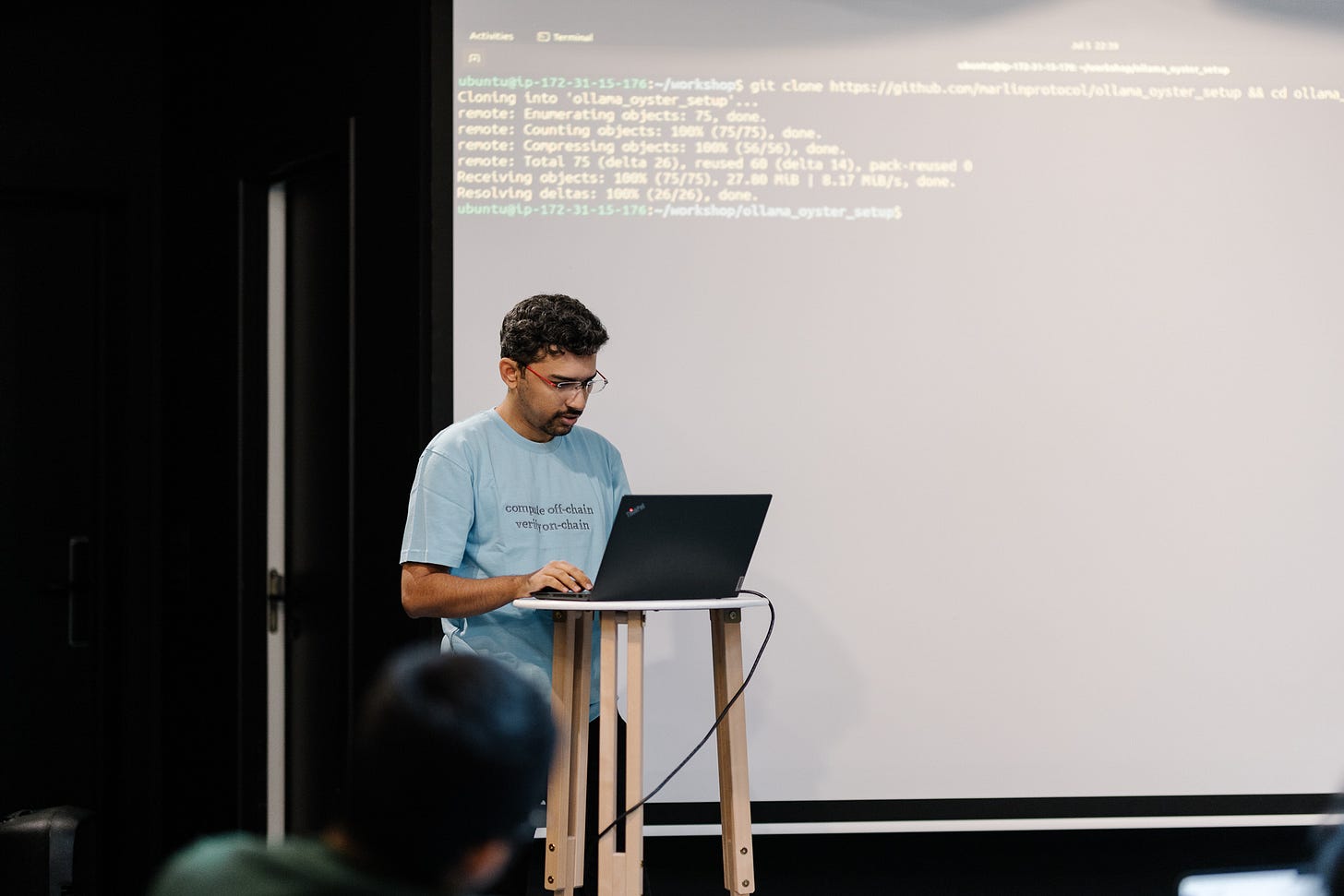AI Centralization Problem: get Insights, Solutions, and a Free Workshop
Discover how to navigate the complexities of AI centralization, gain insights into secure AI model deployment, and access a free workshop.
In the rapidly evolving AI landscape, centralization is a growing concern. Tech giants control both powerful models and the extensive datasets needed to train them, limiting innovation and raising ethical issues.
We’re excited to share insights from a recent article by Marlin, a verifiable computing protocol featuring TEE and ZK-based coprocessors to delegate complex workloads over a decentralized cloud.
The article explores both the opportunities and challenges of moving AI away from centralized control, offering a glimpse into how Web3 could democratize access to AI and foster a more open, transparent, and secure ecosystem.
At the end of this issue, you'll find a link to Marlin's free workshop on Deploying AI agents and models on Oyster TEEs.
The Current State of AI: Centralization at Every Stage
Data Collection and Pre-training: The creation of AI models begins with vast datasets, typically aggregated and controlled by tech giants like Google and OpenAI. This control not only limits who can develop cutting-edge AI but also perpetuates biases within the models, as these datasets are often proprietary and lack transparency.
Fine-Tuning: After pre-training, models are fine-tuned for specific tasks. However, most advanced models remain closed-source, meaning their inner workings are hidden from users. This lack of transparency can lead to mistrust, especially in critical areas, where verifying the accuracy of AI-generated insights is essential.
Inference and Deployment: When AI models are deployed, they often rely on centralized infrastructure for inference — processing new data to make predictions. This creates a bottleneck where access to AI is controlled by a few entities, who can limit or charge for access at their discretion.
The high costs associated with running these models further concentrate power in the hands of a few, making it difficult for smaller players to compete.
Web3 and AI: A New Era of Possibilities
Web3 technologies could disrupt this centralized model, introducing new ways to build, deploy, and interact with AI.
Through decentralized networks, it’s possible to democratize access to the computational power needed for training AI models. Platforms like Decentralized Physical Infrastructure Networks (DePIN) allow developers to access GPU resources without relying on centralized data centers, making it easier for more people to participate in AI innovation.
Advanced cryptographic techniques, such as Zero-Knowledge Proofs (ZKPs) and Fully Homomorphic Encryption (FHE), can ensure that AI computations are transparent and verifiable. These tools enable users to trust that AI outputs are accurate without exposing sensitive data, aligning with the Web3 ethos of transparency and security.
One of the most exciting aspects of Web3 is its potential to create interconnected systems where AI modules can easily integrate and work together. This composability can lead to faster innovation and the development of more sophisticated AI applications, leveraging the strengths of different platforms in a cohesive ecosystem.
With decentralized approaches, users can maintain greater control over their data, deciding how and where it is used. This shift towards data ownership aligns with growing concerns about privacy and the need for AI systems that respect user autonomy.
Challenges of Decentralized AI
While the potential benefits of decentralized AI are substantial, several challenges must be addressed:
Scalability: Decentralized networks can struggle with scaling up to handle the immense computational demands of training large AI models, which may require significant infrastructure investment and optimization.
Interoperability: Ensuring that different decentralized systems and platforms can work together seamlessly is crucial for fostering a cohesive AI ecosystem. This requires standardization and robust integration strategies.
Security: Decentralized systems can introduce new security vulnerabilities, such as risks associated with managing multiple nodes and ensuring the integrity of distributed data. Ensuring robust security measures is essential to protect both the data and the models.
Widespread adoption of decentralized AI requires overcoming resistance from entrenched stakeholders in the centralized model. Building trust and demonstrating the benefits of decentralization are key to encouraging broader acceptance.
Centralization and decentralization offer two very different paths forward. Marlin’s article makes a compelling case for why Web3 technologies are not just an alternative but a necessary evolution for AI. By embracing decentralized approaches, we have the opportunity to create a more equitable, transparent, and innovative AI ecosystem.
To bridge the gap between theory and practice, Marlin hosted a workshop “Deploying AI Agents and Models on Oyster TEEs” at our dAGI House online conference. This session provided a unique opportunity to deepen the understanding of AI implementation best practices:
Secure Deployment: Best practices for deploying AI models in Trusted Execution Environments (TEEs) like Oyster.
Hands-On Experience: Practical exercises to implement and manage AI agents within TEEs.
Technical Insights: In-depth knowledge of the integration between AI and secure execution environments.
Real-World Applications: Strategies for applying these techniques to real-world projects and challenges.
That wraps it up for today! 👋 But before you go...
Check out our LinkedIn, Facebook or Twitter pages for more details. Follow us to stay updated on all the latest news!
Best,
Epic AI team.


